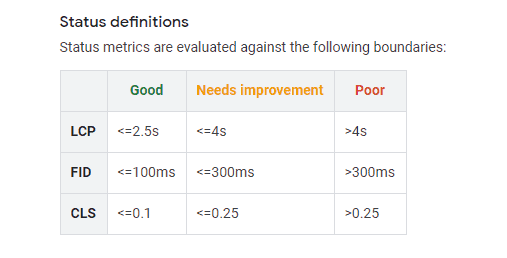From May 2021, Core Web Vitals are set to become an important ranking factor. With this in mind, let’s explore in greater depth how this might affect your search engine optimisation (SEO) strategy.
Core Web Vitals were introduced in 2020 and are specifically designed to measure precisely how users experience the visual stability, responsiveness, and speed of a webpage.

They can be broken down into three areas:
Largest Contentful Paint (LCP)
This Core Web Vital measures the time taken for the main content to load on a webpage. Ideally, your LCP should be below 2.5 seconds. Any webpage with an LCP above 2.5 seconds will benefit from improvements, whereas anything above 4 seconds is classified as poor and requires immediate attention.
First Input Delay (FID)
Ideally, the amount of time it takes for a webpage to become interactive should be less than 100 milliseconds. If interactivity only becomes possible after 300 milliseconds, it is important to implement improvements to minimise this waiting time.
Cumulative Layout Shift (CLS)
The third Core Web Vital looks at the degree of unexpected visual page content shift, which should ideally be below 0.1. A CLS above 0.25 is unacceptable and will benefit from some refinement. Many experts predict that Google will start adding labels in search engine results pages (SERPs) to URLs that will deliver a seamless on-page experience. If tests of this labelling are successful, site owners can expect this feature to launch alongside the update in May 2021.
What Percentage of Websites Currently Pass the Core Web Vitals Test?

Interestingly, a study published in August 2020 by Screaming Frog illustrates that, as it currently stands, only 13% of desktop results and 12% of mobile results would successfully pass a Core Web Vitals assessment.
In most instances, meeting the ideal FID measurement is proving to be a relatively simple task, with 89% of mobile pages and 99% of desktop pages meeting the 100-millisecond target. However, many websites are running into issues regarding both LCP and CLS.
Only 44% of desktop URLs and 43% of mobile URLs currently load their main content within 2.5 seconds, and only 47% of desktop URLs and 46% of mobile URLs currently experience minimal unexpected layout shifts. You don’t need an expert to tell you that from a user experience (UX) perspective, these percentages aren’t great.
How Might Core Web Vitals Affect My Website?
In terms of practising good SEO, we know that Core Web Vitals are, well… going to be vital. But if you aren’t convinced that you’re going to pass the assessment, you’re certainly not alone.
Screaming Frog research discovered that pages occupying the first organic position in SERPs have a mobile pass rate of 19% and a desktop pass rate of 20%. Furthermore, they are 10% more likely to be awarded a pass on the Core Web Vitals assessment than webpages occupying the ninth organic ranking position.
Although Core Web Vitals isn’t an official ranking factor yet, this research illustrates that because page speed is already an important factor and also forms an intrinsic part of Core Web Vitals, we can expect the other two to also play a significant role from May 2021 onwards.
How? Well, pages that are correctly optimised overall already occupy the top-ranking positions in SERPs. So, if you want to ensure that you are one step ahead of your closest competitors, paying attention to Core Web Vitals now is likely to pay off in the long run.
How Can I Measure My Core Web Vitals?
Google currently has six different ways to measure Core Web Vitals, including Search Console and PageSpeed Insights. Notably, Google has reported a 70% increase in the number of people actively engaging with PageSpeed Insights and Lighthouse to evaluate important experience metrics.

It is also worth noting that Google actively recommends Accelerated Mobile Pages (AMP) as a cost-effective and straightforward way to optimise for on-page experience signals.
How Can I Improve My Core Web Vitals Scores?
If you want to ensure that your webpages are correctly optimised, there are several things you can do that are likely to positively impact your Core Web Vitals assessment score, including:
Decrease Visual Load Times by Preloading Key Resources
Preloading is a tactic that can be used to tell browsers to fetch key above-the-fold resources before anything else. This is central to satisfying the LCP Core Web Vital and visually informing visitors that your site is loading as expected.
Austin SEO Ryan Howard recommends first resizing or eliminating any excessive page elements such as images, enabling lazy loading of images below the fold, identifying large external scripts to remove those that aren’t necessary, and moving to a managed hosting provider that automates web image service via CDN. To really max out scores so you’re in the upper 90s on mobile and desktops on Google’s test though, he says, “you likely need to delay loading of big external scripts until after initial mouse movement or scroll”.
Reserve Space for Embeds and Images

We’ve all visited a website and gone to click on a link just before it disappears and gets shifted further down the page as other content loads. To minimise movement of your layout as your webpage loads, make sure you reserve space for both embeds and images, as this will significantly improve your on-page UX.
Understanding Core Web Vitals is one thing, but knowing how to fix associated issues in order to avoid falling foul of Google’s May update is another. We’d always recommend working with a professional and experienced SEO partner with a proven track record and client portfolio in order to optimise your site and avoid falling foul of significant algorithm updates like this one.
